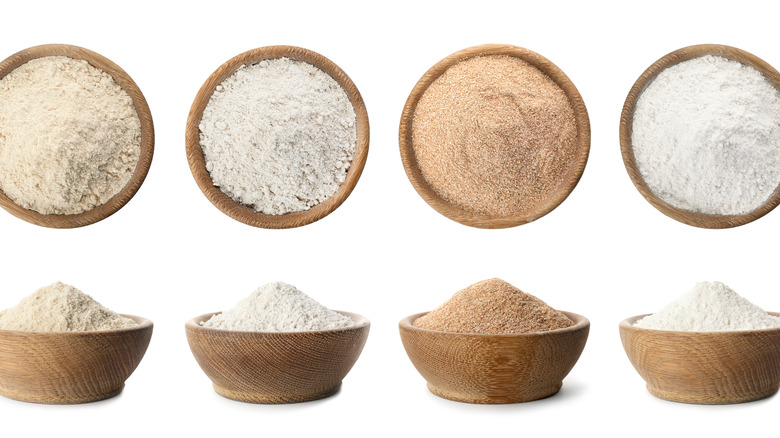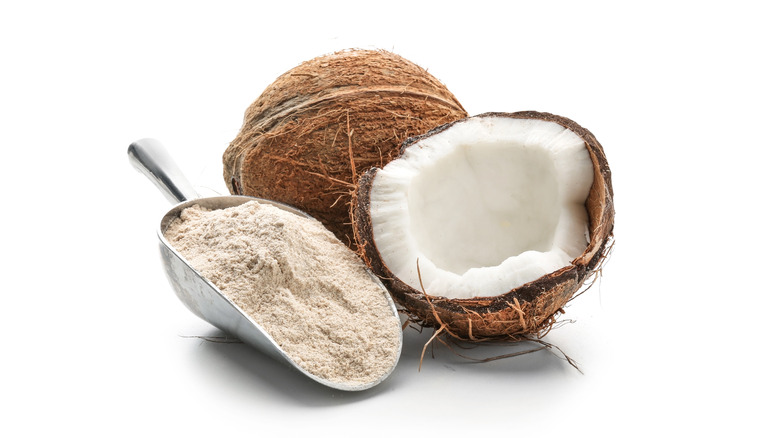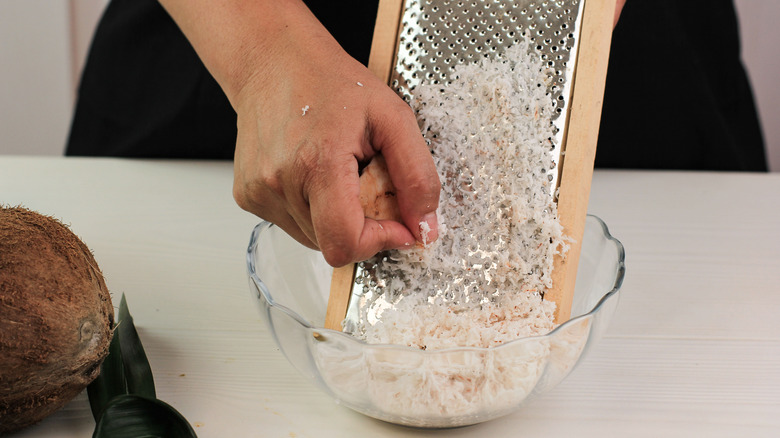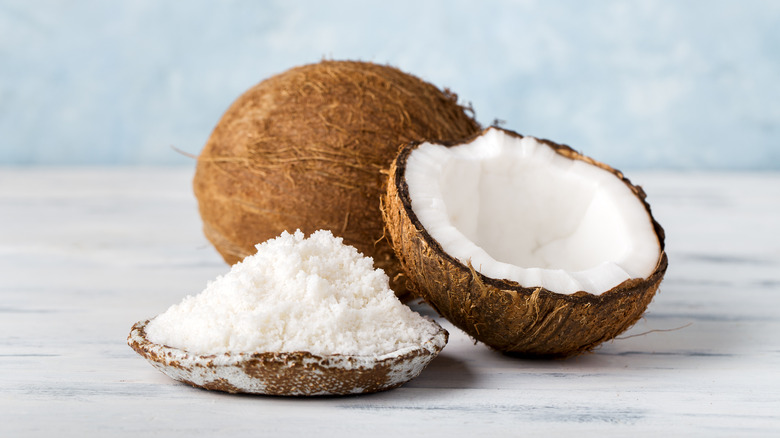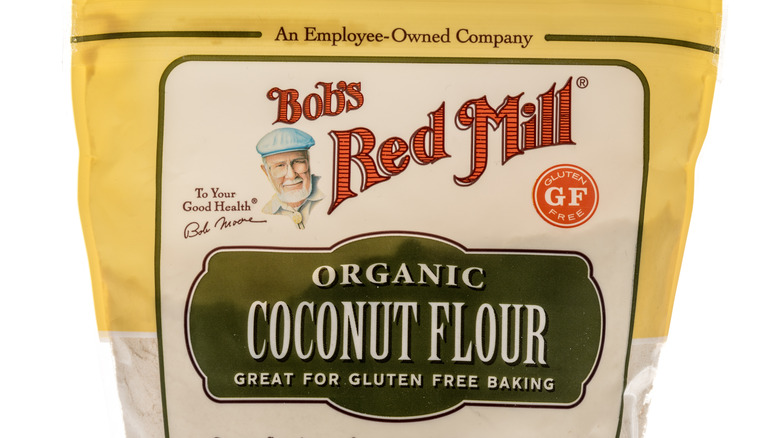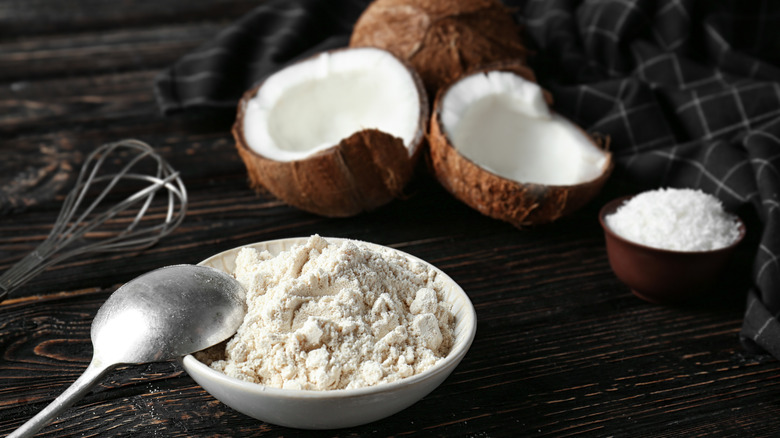What Is Coconut Flour And What Does It Taste Like?
Any home baker can attest to the fact that experimenting with new ingredients can be challenging and unpredictable. The flavors may be uncommon or other characteristics can make them hard to incorporate into a recipe. As well, due to various allergies, it can be tough to bake something that will satisfy a large group of people with various preferences and allergies. In fact, in the case of gluten sensitivity, Science Magazine reports that it has become increasingly widespread in recent years, and alternate options to wheat are now used with more frequency.
Take coconut flour, a gluten-free option that is made from coconuts. Aside from being a useful substitute for wheat flour, this ingredient has a wide range of properties that has led researchers to deem it a functional food, as evidenced by a 2006 study published in Innovative Food Science & Emerging Technologies. Not only does it have possible health benefits, but coconut flour also has a subtly sweet flavor and a crumbly texture that makes it a unique ingredient to work with in all kinds of baked goods.
All the same, it's best not to dive in and substitute coconut flour in equal amounts for all-purpose flour, or you'll end up with a dry pile of crumbs thanks to coconut flour's remarkable capacity to absorb liquids.
What is coconut flour?
Although its present day purpose appears mostly to provide a gluten-free substitute to cater to specific diets and health concerns, Spiceography suggests that coconut flour probably originated in Polynesia. The source notes that the origin of the coconut tree is in Southeast Asia, and the fruit itself likely traveled to other islands by way of ocean currents, ending up in New Zealand and the Philippines, among other spots. According to Spiceography, cuisine from Tahiti and the surrounding islands commonly incorporates the flour into their dishes. Be Still Farms hypothesizes that, originally, the coconut flesh might have been cooked in an Ahima'a, a traditional Tahitian underground oven.
Besides its fascinating history, Healthline points out that coconut flour is a by-product of coconut milk production. It doesn't look especially different from all-purpose flour, though the color may be slightly creamy or ivory. Coconut flour is a great replacement for wheat flour for health, flavor, and textural purposes. Unlike wheat, Healthline reports that coconut flour is free of gluten, grains, and nuts, making it suitable for anyone with associated allergies. As well, Paleo Plan notes that it is a great option for Paleo diets, which doesn't allow for consumption of grains. Likewise, coconut flour's low carbohydrate and high fiber content makes it appropriate for keto diets as well.
How is coconut flour made?
Since coconut flour is a by-product of coconut milk production, it is relatively simple and cheap to make, but also abundantly available in most grocery stores and markets. Healthline explains the process noting that, first, the coconut fruit is cut open and the liquid is collected and set aside. At this point, Foodpreneurs Hub further explains that there are two methods that can be used to make the flour — wet or dry extraction.
The wet technique entails scraping out the coconut meat, grating it into smaller pieces to grind, and then pressing out the milk. The ground product is then dried, before being milled into a powder. The source explains that this method tends to result in a flour with a greater fiber content and coconut flavors are slightly more subdued following this approach.
Meanwhile, the dry technique begins in the same manner by removing the coconut meat and grating it. However, in this method, the grated coconut is first baked at a low temperature until it dries out, and then pressed to release the oils. At this point, the coconut is milled into a fine powder, which is packaged as flour. Compared to the wet method, Foodpreneurs Hub remarks that the dry method yields higher levels of protein. As well, the dry technique tends to entail an elevated fat content compared to the wet method.
What does coconut flour taste like?
Although coconut flour isn't quite the same as taking a bite out of a piece of coconut, its flavor is mildly noticeable. A slight vanilla aroma may also be detected, and the flour is certainly sweeter than the regular all-purpose variety. This is because of the natural sugars in the coconut fruit. This characteristic makes it a good option to use in baked goods to give desired sweetness while minimizing added sugars. On the other hand, it's important to consider this factor if you are using it for anything savory.
There can also be variations across brands, ranging from a subtler to stronger coconut aroma. While the taste fits well with a number of baked goods, it can overpower the overall profile if it's paired with subtler flavors. However, when complemented by stronger ingredients such as coffee, chocolate, or banana, coconut flour is an ideal match.
Aside from the flavor, coconut flour has a soft, rich texture with a unique crumb that makes it well suited for baked goods.
How to cook with coconut flour
Coconut flour is versatile and can be used raw or cooked since it is baked during processing, according to One Green Planet. While it's great all on its own, you can also pair it with other gluten-free flours such as almond and buckwheat for enhanced taste and texture. You'll just first want to sift the flour to avoid lumps or grittiness. Thanks to its texture, coconut flour can be used to thicken soups, sauces, stews, and smoothies. You can even use coconut flour to batter food, however A Saucy Kitchen advises using it with another starch if you want crispier results.
Coconut flour is certainly distinct, however it can still be used to make all of your favorites — cookies, pancakes, muffins, cakes, and the like. Most significantly, Healthline indicates that coconut flour absorbs a large amount of liquid. As such, the source advises replacing 1 cup of all-purpose with 1/4-cup of coconut flour, and adding an equal amount of water to the coconut flour used.
Similarly, you can also incorporate eggs to lighten the texture and set yourself up for success. To do so, separate the whites from the yolks, beat the yolk with the flour, and finally whisk the whites into peaks and add them to the mixture. If you don't have the patience, just be sure to add sufficient eggs and water, and leave the batter to sit for a few minutes to see if it requires additional liquid (via Spiceography).
Where to buy coconut flour
Thanks to the influx in interest for wheat flour alternatives, coconut flour and other substitutes can be found with increasing ease – Costco, Walmart, Target, Whole Foods, and similar large stores will usually carry coconut flour. It is generally kept with other flours or near gluten-free replacements, or can also be spotted in the health food aisle. As well, most natural food shops that carry an assortment of flours should stock coconut flour in their selection.
If you're a fan of shopping online, look no further than Amazon or the official site for Bob's Red Mill. Keep in mind that coconut flour bought in bulk might risk cross contamination and should not be considered a safe option if gluten or nut allergies are involved.
If you have the luxury of choice, One Green Planet recommends opting for raw, organic coconut flour as it contains all of the fruit's natural enzymes unlike more processed versions, which might have been bleached. A good sign to identify if it has been thoroughly processed is whether the color is especially white — you'll want to avoid those if you want a more raw version.
Once you've purchased your bag of coconut flour, there's guidelines you should follow to keep it at its maximum freshness. Since coconuts contain plenty of oil, the flour risks developing rancid flavors if it isn't appropriately stored. Well Plated advises to keep it sealed in the fridge for up to six months or in the freezer for 12 months.
Nutritional information about coconut flour
You don't have to be allergic to gluten, grains, or nuts to enjoy coconut flour. Healthline reports that it's also a nutritive ingredient, containing plenty of fiber, protein, and healthy fats. In fact, the site notes that coconut flour contains ten times more fiber than equal amounts of all-purpose flour, which may help contribute to a healthy heart, digestion, and gut bacteria. Similarly, a 2003 study in The British Journal of Nutrition remarked that the fiber content of coconut products can be associated with a low glycemic index, a measure of how different foods cause a rise in blood sugar. Spiceography notes that this feature alone makes coconut flour a good option for people with diabetes.
Thanks to high levels of protein and fiber, coconut flour contributes to satiation, too, which can assist with weight management. Healthline explains that coconut flour contains medium-chain triglycerides, a type of fat associated with weight loss since it is used by the liver as an immediate energy source. The source notes that it also contains lauric acid, a fat that can reduce plaque in the arteries.
As for micronutrients, Nourished Kitchen reports that this flour is rich in iron, manganese, potassium, and vitamin B, among others. Due to these impressive characteristics, coconut flour has been deemed a functional food and even a superfood in some cases.
While coconut flour is a great option with numerous benefits, Nourished Kitchen indicates that it contains salicyclates, natural chemicals in certain fruits that can cause headaches or eczema in some cases, so it's best to take caution if those ailments might be an issue. Otherwise, coconut flour in many ways is a star ingredient for bakers.
